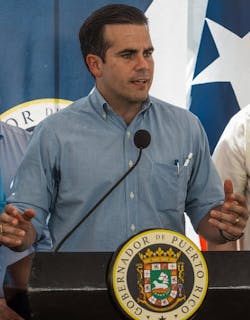“We want microgrids everywhere,” said Puerto Rico Gov. Ricardo Rosselló in a recent discussion of his Energy 2.0 plan and a future that allows citizens to choose whether they want to stay on the grid or leave it.
Part of his “New Vision for Puerto Rico” speech at the Aspen Ideas Festival June 26, Rosselló’s remarks signaled the continued push to modernize the island’s electric grid with microgrids, renewable energy and energy storage.
Aptly, the government also issued a Request for Qualifications (RFQ) for energy storage around the same time.
Microgrids part of bigger plan
In his speech, Rosselló noted that 98 percent of the island’s energy comes from fossil fuels and that he wants to transition to 40-45 percent renewable energy.
“This is an opportunity to leapfrog into the future and create an Energy 2.0 model,” he said, noting that the island is in a unique position to change its energy infrastructure. Its electric grid is being rebuilt after massive destruction from last September’s Hurricane Maria.
Puerto Rico can use some of its recovery funds, invite private partners to participate, and create a “robust”regulatory framework that provides for the best possible prices, he said.
The island wants to stop using fuels that are damaging its environment and create a system that’s more resilient and reliable, he said.
Energy prices in Puerto Rico are now about 35 cents/kWh, said the governor. “We want to lower the costs. This is a major driver of economic growth,” said Rosselló. “We want distributed generation. We want microgrids everywhere within the island, different alternatives.”
New energy storage RFQ for Puerto Rico
The energy storage RFQ, issued by the Puerto Rico Public-Private Partnerships Authority, along with the Puerto Rico Electric Power Authority (PREPA), said that PREPA faces financial challenges, an outdated system and the problem of generation located on the south side of the island, while the north side has the biggest load.
“PREPA is facing a fundamental challenge as it looks to remain financially sustainable for the long term. In addition to financial challenges, PREPA’s electric system remains fragile and relatively unreliable in the aftermath of Hurricanes Irma and Maria,” said the RFQ.
PREPA’s goals include diversifying its energy sources and taking advantage of advanced technologies, said the RFQ.
The RFQ seeks a 20 MW/20 MWh system with the flexibility and modularity to expand to 40 MW/160 MWh. The energy storage system should be capable of providing ancillary services, including voltage and frequency control and regulation. And the project should help PREPA meet load variations related to the intermittency of renewable generation, according to the RFQ.
The chosen private developer will finance, design, construct, and maintain an energy storage system connected to PREPA’s distribution system.
The agencies hope to use funds provided under the Puerto Rico Oversight Management and Economic Stability Act, saying this project could spur sustainable economic development.
Respondents to the RFQ must show they have the technical, financial, and operational experience to install and operate the storage system for a 10- to 30-year term.
PREPA expects to pay the supplier for capacity on an annual basis, and the supplier will be responsible for guaranteeing the system’s performance. The authority will control the system and be responsible for the energy needed to charge the storage system.
Advances public private partnerships
“Governor Rosselló has taken unequivocal steps for improving the public-private partnerships (PPP) framework and advancing bankable projects,” said the RFQ.
In January and August 2017, the governor created amendments to the PPP program that allow for unsolicited proposals, pre-development agreements and facilitation of the approval procedures for projects under the PPP legislation.
“This project forms an integral part of the government’s and PREPA’s fiscal plan, which, among its many objectives, seeks to advance PPPs as a way to revitalize infrastructure and spur economic development,” said the RFQ.
RFQ submissions are due August 3, and the agencies plan to select their shortlist on August 17. The selected applicants will then be invited to participate in a request for proposals.
The RFQ is available for download from the Puerto Rico Public-Private Partnerships Authority.
“What I’m really excited about is giving consumers control and making our system customer-centric,” said the governor in his speech. “The people of Puerto Rico will be able to choose if they stay within the grid or if they opt out. We can make micro or nanogrids,” said Rosselló .
Track news about microgrids in Puerto Rico. Subscribe to the free Microgrid Knowledge newsletter.








